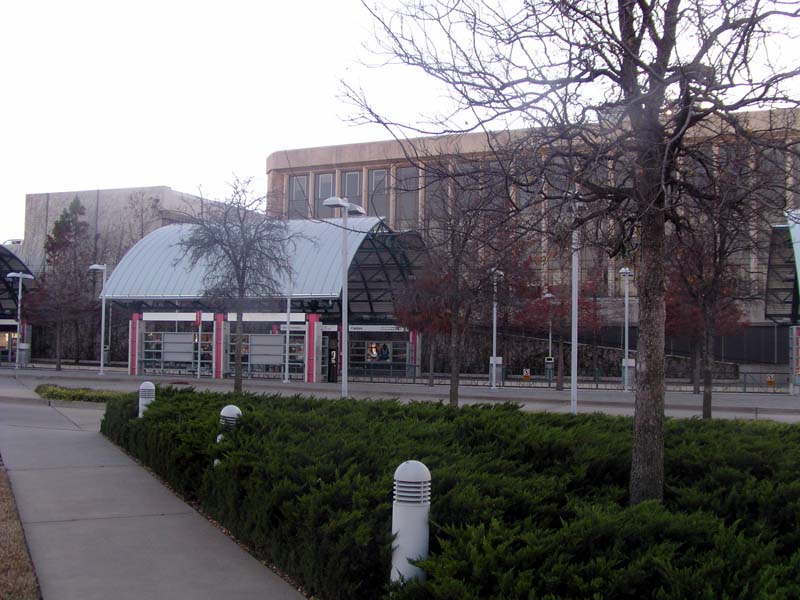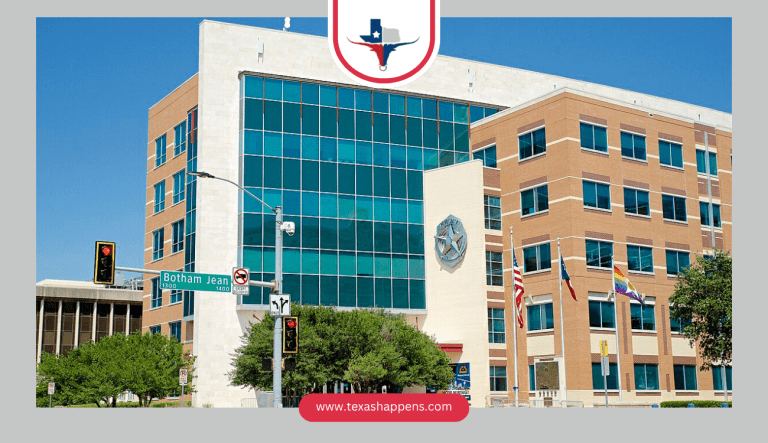The Cedars is one of Dallas’s oldest neighborhoods, dating back to the late 1800s. What began as a wealthy residential area soon transformed into an industrial and commercial hub before becoming the artistic and cultural district it is today.
Image: Danazar, Botham Jean Blvd – Dallas Police HQ – June 2021 – 02, CC BY-SA 4.0
From Victorian Homes to Urban Revival
Three distinct eras have shaped the Cedars neighborhood’s rich historical fabric. In the late 1800s, it was a thriving Jewish community living in moderately-priced Victorian homes, setting the foundation for architectural preservation efforts that continue today.
By the 1920s, the neighborhood transform as light industry moved in and population demands grew, marking a significant shift from its Victorian roots.
The 1960s brought dramatic changes when highway construction claimed most of the original homes, leaving only a few historic structures standing. Now it is a captivating blend of cultural preservation and urban renewal as creative professionals and artists breathe new life into the area. The city and residents are working together to honor the neighborhood’s legacy while building a vibrant future for this evolving community. The area’s connection to Dallas’ earliest days is preserved through Browder Springs, which provided the city’s first water supply.
Some notable landmarks include:
- The Ambassador Hotel – Originally built in 1904, this historic hotel once hosted prominent guests but has since faced challenges with restoration.
- Dallas Heritage Village – Located nearby, this museum preserves historic homes and buildings, giving visitors a glimpse of what life was like in early Dallas.
- Old Industrial Buildings – Many old warehouses and factories have been transformed into residential lofts and office spaces, maintaining their original charm.
View this post on Instagram
Artists and Cultural Development
Building on its historic evolution, the Cedars has emerged as Dallas’s premier artistic enclave. You’ll uncover a neighborhood where artistic collaborations thrive through spaces like the South Dallas Cultural Center, The Cedars Union, and the MAC. For over two decades, creative professionals have made this area their home, establishing a lively community that continues to grow.
The neighborhood’s commitment to artistic expression has created an atmosphere where creativity isn’t just welcomed – it’s celebrated as an essential part of daily life. Much like Austin’s thriving music scene coverage, the Cedars has become a focal point for capturing and celebrating local artistic achievements.
Some of its key attractions include:
- South Side Ballroom – A well-known venue that hosts concerts, live performances, and events.
- Four Corners Brewing Co. – A popular craft brewery that has become a local favorite.
- Cedars Union – A collaborative space supporting local artists and creative projects.
- Gilley’s Dallas – A legendary entertainment venue with deep ties to Texas music history.
Neighborhood Transformation and Growth

Image: Drumguy8800, Cedars Station, CC BY-SA 3.0
Over the past two decades, the Cedars has transitioned from a declining district into one of Dallas’s most lively neighborhoods. You’ll find that urban planning initiatives have played an indispensable role in this metamorphosis, starting with the establishment of the Cedars Neighborhood Association in 2003. The organization’s neighborhood revitalization strategies have attracted new developments while preserving the area’s unique character.
Key improvements include the $21 million Bridge homeless shelter, which has effectively addressed homelessness concerns, and the addition of the DART Cedars Station, enhancing connectivity. You’ll notice modern townhomes and renovated lofts now stand alongside historic buildings, while the Dallas Police Headquarters adds to the area’s stability.
From Warehouses to Modern Residences
Living spaces in The Cedars showcase an extraordinary transformation from industrial to residential, exemplified by the striking conversion of former warehouses into fashionable lofts and townhomes. You’ll find remarkable architectural diversity throughout the neighborhood, with Southside on Lamar standing as a prime example of adaptive reuse of historic buildings. Similar to the successful West End Historic District revitalization that began in 1976, The Cedars has embraced its industrial heritage through thoughtful preservation.
Dining and Entertainment Scene
View this post on Instagram
The Cedars’ culinary domain matches its distinctive residential character, offering an array of dining experiences that range from casual neighborhood haunts to upscale establishments. You’ll find artisanal food purveyors at every turn, from the contemporary American cuisine at The Cedars Social to the comfort foods at Full Circle Tavern, where you can bring your four-legged friend along.
For local craft beverages, you’re spoiled for choice. Sample Texas wines and craft beers at Checkered Past Winery, or unwind with creative cocktails at The Cedars Social. If you’re a coffee enthusiast, Opening Bell Coffee serves up fresh brews and pastries, plus live music performances.
Transportation and Accessibility
Connected to the heart of Dallas via multiple transit options, The Cedars boasts exceptional accessibility that makes urban living a breeze. The neighborhood’s walkable infrastructure lets you enjoy the area’s amenities on foot, while its multimodal connectivity guarantees you’re never far from your destination.
Cedars’ prime location offers the perfect balance of connectivity and convenience. With multiple transportation choices at your disposal, you can easily traverse both the neighborhood and the broader Dallas metropolitan area.
View this post on Instagram
Community Initiatives and Social Impact
Beyond its physical connections, The Cedars shines through its strong community spirit and collaborative initiatives. You’ll find remarkable examples of community engagement through organizations like the Cedars Neighborhood Association, which has been nurturing economic and cultural development since 2003.
The neighborhood’s social entrepreneurship is evident in projects like The Bridge, a comprehensive homeless shelter that’s made a significant positive impact since 2008.
The community’s creative spirit comes alive during events like Cedar Open Studios, where you’ll experience the neighborhood’s thriving arts scene firsthand.
View this post on Instagram
Economic Development and Future Prospects
With its strategic location near downtown Dallas, The Cedars has experienced substantial economic growth over the past decade. You’ll find numerous business opportunities emerging as infrastructure investments continue to reshape the neighborhood. The area’s revitalization has attracted entrepreneurs and developers who recognize its untapped potential.
- New mixed-use projects combining residential, retail, and office spaces
- Enhanced public transportation connections and improved streetscapes
- Tech startups and creative businesses establishing their headquarters
As property values rise and more businesses move in, you’ll witness The Cedars becoming an even more dynamic economic hub. The neighborhood’s ongoing transformation promises to create a sustainable balance between preserving its unique character and promoting modern development opportunities.
Final Thoughts
The Cedars stands out as one of Dallas’s most dynamic neighborhoods, shaped by history, industry, art, and reinvention. Its transformation from a wealthy residential district to an industrial hub and now an artistic community is a testament to its resilience.


